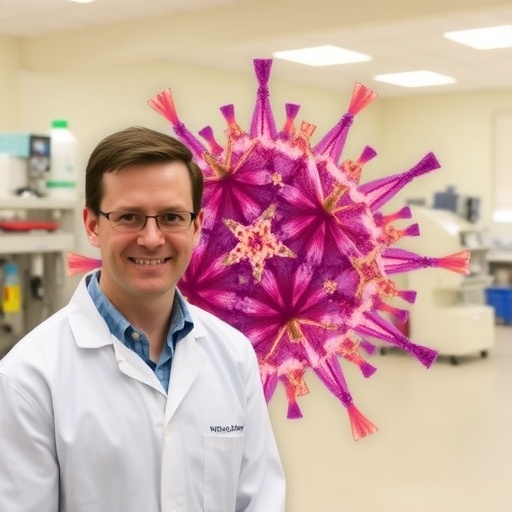In a monumental stride for astrophysics and plasma physics, a distinguished team of scientists from the U.S. Department of Energy’s Princeton Plasma Physics Laboratory (PPPL) alongside Princeton University has been honored with the 2025 John Dawson Award for Excellence in Plasma Physics Research by the American Physical Society. This accolade celebrates their pioneering exploration into the enigmatic phenomenon of magnetorotational instability (MRI), a subtle, yet profoundly influential wobble within disks of swirling matter that orchestrates the formation of stars, planets, and even supermassive black holes. Their groundbreaking work not only elucidates the origins of cosmic structures but also redefines experimental approaches by successfully simulating these celestial processes within the confines of a terrestrial laboratory.
Understanding the intricate dynamics of MRI has long been a scientific aspiration due to its central role in astrophysical phenomena. This instability arises in accretion disks—vast, rotating structures of gas, dust, and plasma enveloping young stars or black holes—where a delicate imbalance in rotational velocity fosters turbulence. This turbulence facilitates the inward spiral of matter by transferring angular momentum outward, thereby enabling mass accumulation essential for planet and star formation. Directly observing or experimentally verifying these processes has been notoriously difficult, primarily due to the immense scales and environments involved.
The team comprises eminent researchers including Fatima Ebrahimi, Erik Gilson, Hantao Ji, Yin Wang from PPPL, and Princeton astrophysics professor Jeremy Goodman. Together, their efforts have unfolded over two decades, fusing theoretical insights with avant-garde computational simulations and meticulous laboratory experiments. Their innovative approach entailed re-creating the elusive MRI within specially designed experimental setups, bridging the expanse between abstract theory and tangible evidence.
One of the project’s formidable challenges was replicating outer space’s unfettered conditions in a laboratory setting, where physical boundaries and container geometries inevitably influence experimental outcomes. The cylindrical vessels utilized introduced edge effects that could obscure the genuine manifestation of MRI turbulence. Overcoming these intricacies required years of refinement to isolate and verify the instability beyond any boundary-induced artifacts, marking an extraordinary achievement in experimental plasma physics.
Ji, a principal investigator, emphasizes the cosmic significance of their discovery, articulating that this process is not just an astrophysical curiosity but an indispensable mechanism underpinning the emergence of planets, stars, and thereby life itself. This dynamic instability uniquely depends on plasma states and magnetic fields—areas wherein PPPL has established deep scientific expertise. The synergy between magnetic fields and ionized matter materializes the MRI-induced wobble, effectively knitting the fabric of the universe’s structure.
The investigative focus on liquid metals as analogs to plasma within the laboratory setting represented a pragmatic and strategic choice. While plasma is the prime medium in space, replicating it under controlled laboratory conditions posed significant practical hurdles. Liquid metals, capable of conducting electricity and flowing smoothly, provided an accessible surrogate that enabled precise manipulation of rotation speeds and magnetic field strengths within nested cylinders. This methodology allowed researchers to rigorously dissect the onset and behavior of MRI under conditions imitative of astrophysical disks.
Beyond merely validating theoretical models, the experimental approach has propelled PPPL’s burgeoning expertise in liquid metal physics. This expertise is crucial not only for astrophysical simulations but also for advancing fusion energy technologies, where liquid metals are poised to play a pivotal role in managing plasma-material interactions and heat transfer. The MRI studies thus represent a convergence of astrophysics and applied plasma science, fostering innovations across multiple domains.
Jeremy Goodman recounts the project’s inception following an astophysical seminar at PPPL, highlighting the persistence required to transform a conceptual inquiry into empirical verification. The collective endeavor exemplifies collaborative science, where interdisciplinary knowledge and technological advancements coalesce to unravel complex natural phenomena. This synergy has culminated in a robust experimental demonstration of MRI, a phenomenon hypothesized since the latter half of the 20th century but only now artfully captured and analyzed.
The team envisions extending this research horizon by intensifying experimental parameters—augmenting magnetic fields, accelerating rotational dynamics, or constructing larger-scale apparatuses—to further elucidate MRI’s properties and effects. These ambitions promise to deepen comprehension of turbulent processes that govern not only astrophysical bodies but also various plasma environments, potentially catalyzing new discoveries in fundamental physics.
The John Dawson Award, a prestigious recognition within the plasma physics community, reaffirms PPPL’s legacy of exceptional scientific contributions. Past recipients from the laboratory have continued to set benchmarks in theoretical and experimental plasma physics, accentuating PPPL’s position as a world leader in the field. The award ceremony scheduled for the APS Division of Plasma Physics annual meeting in Long Beach, California, will spotlight this landmark achievement alongside ongoing innovations in plasma science.
Collaborations underpin the success of this venture, involving a diverse network of researchers from institutions internationally renowned for plasma and astrophysical research. These partnerships have provided critical insights, experimental resources, and theoretical frameworks necessary for tackling the complex, multiscale nature of MRI. Support from federal agencies, including the Department of Energy, National Science Foundation, and NASA, has been instrumental in sustaining long-term research endeavors that fuse plasma physics with cosmological phenomena.
At the core of this venture lies a profound testament to scientific curiosity and ingenuity, rendering some of the universe’s most elusive processes comprehensible through sophisticated experimentation and theory. By capturing the subtle dance of plasma and magnetic fields that orchestrates cosmic formation, the researchers have not only unveiled a fundamental astrophysical mechanism but also paved pathways for future explorations destined to decode the universe’s grand narrative.
Subject of Research: Magnetorotational Instability and its role in star, planet, and black hole formation.
Article Title: Scientists Recreate Cosmic Swirling Matter Wobbles in Lab, Unlocking Secrets of Star and Planet Formation
News Publication Date: 2025
Web References:
– https://www.pppl.gov/news/2025/new-way-wobble-scientists-uncover-mechanism-causes-formation-planets-0
– https://www.pppl.gov/news/2023/breakthrough-pppl-confirmation-key-theory-behind-formation-planets-stars-and-supermassive
– https://www.aps.org/funding-recognition/award/john-dawson-award
References:
– American Physical Society, John Dawson Award for Excellence in Plasma Physics Research
– Research publications by Fatima Ebrahimi, Hantao Ji, Jeremy Goodman, et al., PPPL and Princeton University
Image Credits: Michael Livingston / PPPL Communications Department
Keywords
Black holes, Plasma physics, Physics, Planets, Stars





